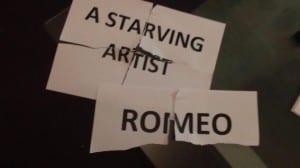So our performance is done. We arrived on the day of our performance with our bags of cardboard in hand, a back pack full of as many props as we could source and the hope that we would entertain whatever audience that we had. My partner and I had one goal in mind when it came to our performance, and that was to simply have some fun with it. And we did.
Although at the start of our dress run, our nerves were hitting new heights, we knew that if we adhered to the rules that we had put in place for ourselves, that we would come out of our performance happy with it. And I’m ecstatic to say that nothing went wrong with the dress run, which helped to settle our nerves a little bit. But we did feel as if we were missing something however, and we couldn’t quite place what that was exactly.
We spread our props along the floor, so that during the performance we would simply pick up our cardboard, show it to the audience, grab whatever prop we may or may not have needed, and go full steam ahead into which ever character we were performing within that minute. Having the props littered across the stage was an idea that we had wanted to use for a while leading up to the performance, however we couldn’t execute it until show day. We believed that by having these props all over our stage, and be reusing them, that we would then, in some way, be ghosting our own performance. Audience members would see props that had already been used minutes before in a new role, and in a new light, and that would directly reference what had already been seen by them.
As we performed our piece; ‘Something Long and Impossible to Pronounce’ to our audience, my partner and I realised what it was that had been missing from our performance all along. It was the people who came to see it; our audience. While we had had a great time rehearsing our piece and performing it in our living rooms, it was a fantastic experience to be able to show it to all of those who came along to see it. The feedback we have received so far has been positive, with audience members informing us about how engaged and entertained they were. We feel that because we had that audience there watching us, we were able to perform to a higher standard, and enjoyed the piece a lot more having finally got the chance to show it to the world.
What had been a kind of rocky process with a lot of decision changing along the way, turned into one of the most entertaining pieces of theatre and performance that I have ever had the pleasure of being involved in, and I would most definitely love to expand on our piece again someday if the chance ever arose.
